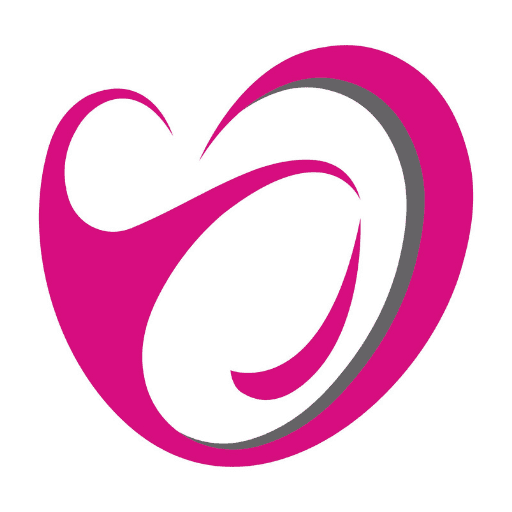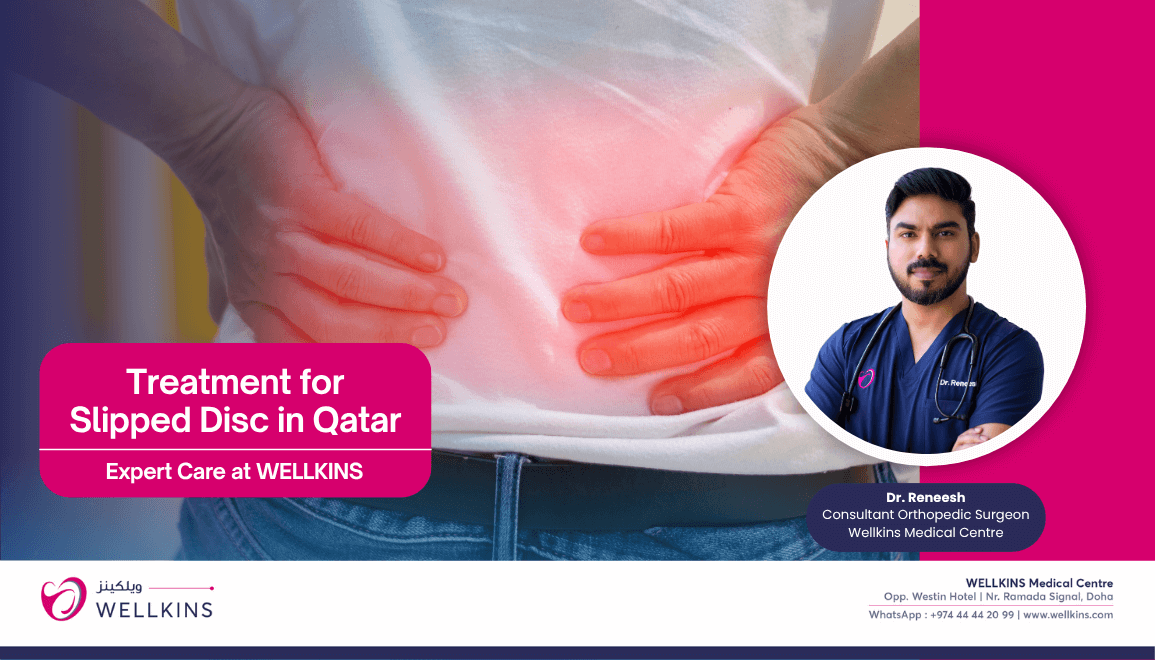Author: Dr. Reneesh (Consultant Orthopedic Surgeon – Wellkins Medical Centre)
we understand the distress and disruption that back and neck pain can bring. If you’ve been diagnosed with a herniated disc, or if you suspect you have one, this guide informed by specialized orthopedic knowledge will help you understand your common condition and your best path to recovery. So, what exactly is a Herniated Disc? Imagine your spinal discs as small, resilient “jelly donuts” positioned between the bones of your spine (vertebrae), acting as essential shock absorbers. Each disc has a tough, fibrous outer ring (annulus fibrosus) and a soft, gel-like inner core (nucleus pulposus).
A herniated disc often called a slipped, bulging or ruptured disc occurs when a tear develops in the tough outer ring, allowing the soft inner material to push out. This protruding material can then press directly on a nearby spinal nerve, causing the sharp, debilitating pain often associated with a “pinched nerve” or sciatica. This pressure can not only cause pain but also interrupt the nerve’s signaling, leading to numbness or weakness.
“Successfully recovering from a slipped disc or pinched nerve in Qatar requires more than just pain medication; it demands addressing the underlying mechanical issues, from strengthening the core muscles to correcting poor posture and lifting habits. Since chronic pain, functional limitation and the fear of surgery are often linked to treatment delays and poor outcomes, a well structured recovery plan that includes precise diagnosis, inclusive non-surgical care, and patient education is essential for the long-term journey of restoring mobility and maintaining spinal health, not just masking the immediate symptoms.”
Common Causes & Risk Factors of Slipped Disc
While sudden trauma can cause a herniation, the most common reason is age-related wear and tear. Over time, discs naturally lose water content, making them less flexible and more vulnerable to tears during minor stress. The loss of hydration makes the discs less effective at cushioning, similar to a tire losing air pressure.
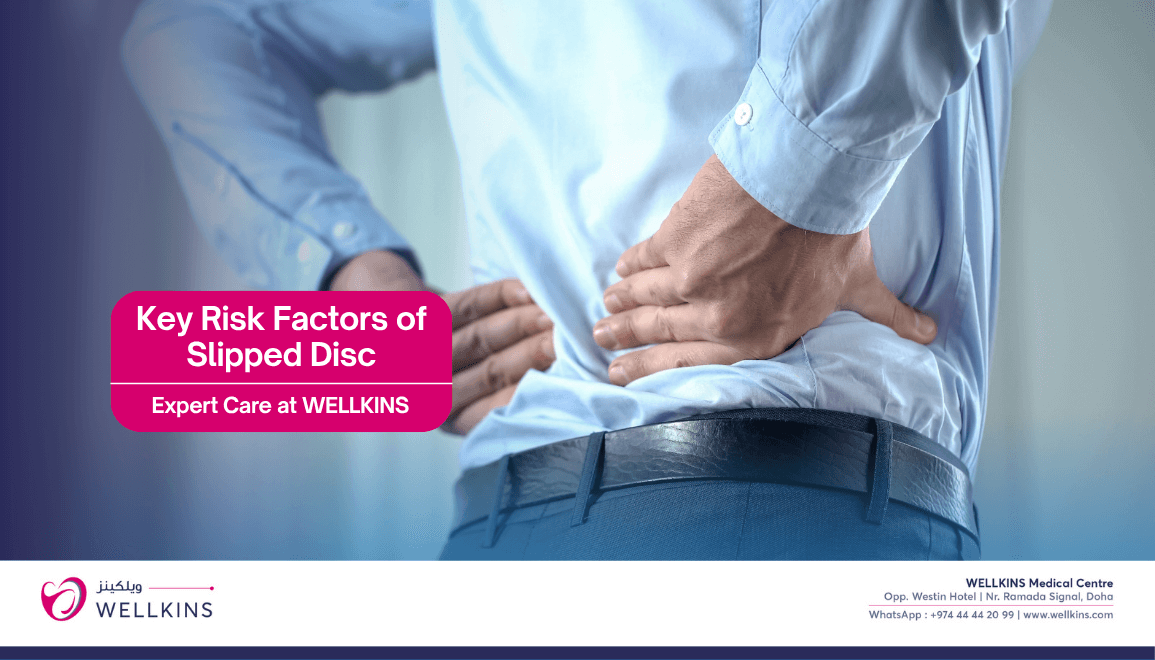
Key Risk Factors:
Age: Most common in people aged 30-50, as disc degeneration is often underway.
Improper Lifting: Using your back instead of your legs when lifting. This places enormous shearing force on the lumbar discs.
Weight: Excess weight puts continuous, additional stress on the spine. Even a small increase in body weight can significantly multiply the force exerted on the lower back.
Lifestyle: Smoking (reduces oxygen to the discs, hindering repair) and a sedentary lifestyle (which prevents the strengthening of crucial supporting muscles). Genetics also play a role, as some individuals are simply predisposed to weaker discs.
Signs and Symptoms
- Sharp or burning pain in the lower back
- Pain radiating down one leg (sciatica)
- Numbness or tingling in the leg or foot
- Muscle weakness in the affected leg
- Pain worsens with sitting, coughing, or sneezing
- Neck pain and stiffness
- Pain radiating into the shoulder, arm, or hand
- Numbness or tingling in the arm or fingers
- Muscle weakness in the arm or hand
- Headaches
Red Flag Symptoms (Seek Immediate Medical Attention)
While most pain can wait, you should immediately visit the Emergency Department or contact us if you experience:
- Loss of bowel or bladder control. (A sign of Cauda Equina Syndrome, a serious nerve compression issue).
- Progressive weakness in both legs.
- Numbness in the groin or inner thigh area (Saddle Anesthesia).
- Severe pain following a major trauma, such as a car accident or significant fall.
Diagnostic Investigations and Clinical Examination
At Wellkins Medical Centre, your evaluation begins with a thorough clinical examination to assess your reflexes, strength, range of motion, and pain triggers (like the straight leg raise test). We often use these physical findings to accurately predict the level of the disc involvement before imaging.
- Range of motion in your spine
- Muscle strength and reflexes
- Areas of numbness or tingling
- Specific tests like the straight leg raise test
1. Various Imaging Studies for Diagnosis
Various imaging studies are used for the diagnostic evaluation of slipped disc in Qatar, Such as:
X-rays
To rule out fractures, instability, arthritis, or other primary bone problems that might mimic disc pain. However, it’s crucial to understand that X-rays cannot directly visualize a disc herniation or “slipped disc,” as the discs themselves are soft tissue. For treatment planning, if symptoms strongly suggest a slipped disc after bone problems are excluded, we rely on the patient’s physical exam and often proceed to an MRI to confirm the soft tissue injury and guide specific, targeted treatment.
MRI Scan
For a precise diagnosis, we rely on MRI (Magnetic Resonance Imaging). MRI scan provides detailed images of the soft tissues the disc itself and the affected nerve roots allowing us to pinpoint the exact location and severity of the herniation. While X-rays show bone and can rule out fractures, only an MRI gives us the clarity needed to see the disc material pressing on the nerve.
CT Scan
If an MRI is unavailable or contraindicated (for example, due to a patient having certain metallic implants), a CT scan becomes a valuable alternative in evaluating potential slipped disc issues. While a standard CT mainly shows bone, its utility is significantly enhanced when combined with a contrast dye injection into the spinal canal a procedure called a CT myelogram. This dye outlines the nerves and spinal cord, allowing us to see how the soft disc tissue may be pushing into and compressing the nerves. This detailed image is crucial for confirming the presence and location of a disc herniation, ensuring we can plan the most effective and targeted treatment strategy.
Nerve Conduction Studies/EMG
Nerve Conduction Studies (NCS) and Electromyography (EMG) are indispensable tools when managing a slipped disc, as they move beyond imaging to assess the function of the nerves. These tests measure electrical activity in muscles and nerves, providing objective evidence of nerve damage caused by the herniated disc. Critically, the EMG helps us identify exactly which nerve roots are affected and the severity of the compression. This functional information is often necessary for distinguishing true nerve impairment from other types of pain, making it extremely useful for guiding non-surgical treatment and, more importantly, for surgical planning to ensure the decompression procedure targets the correct, injured nerve root.
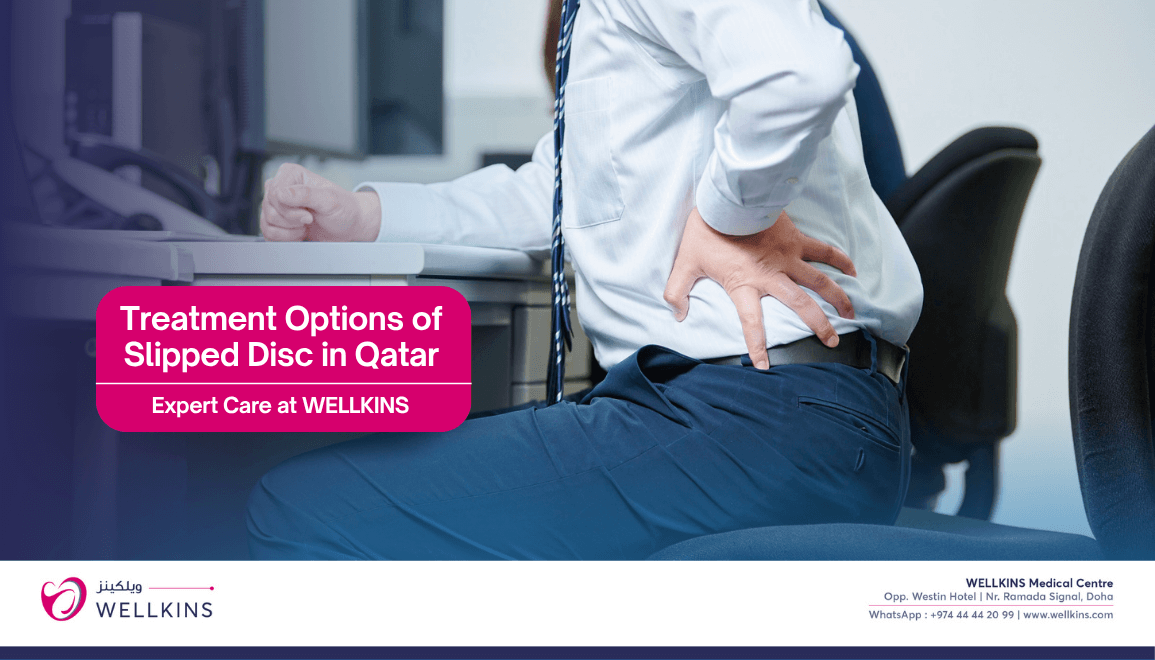
Treatment Options for slipped Disc
Treatment for a slipped disc generally follows a conservative path initially, focusing on pain and inflammation management (medication, physical therapy, and rest). If symptoms persist or worsen, the next step involves targeted injections to deliver steroids directly to the affected nerve root. Surgery is typically reserved as a last resort for severe cases involving neurological deficits or unrelenting pain.
1. Conservative Treatment (Non-Surgical)
Medication: Use of NSAIDs to manage pain and inflammation, or specialized neuropathic pain medications for nerve relief.
Physical Therapy: This is crucial. Our therapists focus on core and back muscle strengthening for spinal support, combined with flexibility and stretching exercises. PT is essential because strong, flexible muscles stabilize the spine, reducing the load on the damaged disc.
2. Surgical Treatment (When Conservative Care Fails):
- Conservative treatment fails
- Progressive neurological symptoms develop
- Significant functional impairment persists
If non surgical options fail to provide relief after several months, or if you develop progressive neurological symptoms (like increasing weakness or severe functional impairment). The most common procedure is a microdiscectomy, a minimally invasive surgery to remove the piece of disc pressing on the nerve. Minimally invasive techniques mean smaller incisions, less muscle damage, and generally a faster recovery time compared to traditional open surgery.
Potential Complications Without Treatment
- Chronic pain and disability
- Progressive nerve damage
- Permanent weakness or numbness
- Cauda equina syndrome (rare but serious)
Prevention of Slipped Disc
Preventing disc issues is always easier than treating them. Adopt these simple, effective strategies:
Exercise and Fitness: Focus on core strengthening (strong abs and back muscles) and low-impact activities like swimming or walking. Aim for a balanced routine that includes both strength and flexibility training.
Proper Body Mechanics: Always bend your knees and keep your back straight when lifting, using your legs, not your back. Avoid twisting while holding weight; instead, move your whole body by turning your feet.
Workplace Ergonomics: Ensure your desk is set up correctly with lumbar support, and make sure the top of your monitor is at eye level. Take regular standing and stretching breaks every 30-60 minutes to relieve pressure.
Lifestyle Modifications: Maintain a healthy weight, quit smoking, and stay hydrated. A quality mattress and proper pillow are also essential for maintaining spinal alignment while sleeping.
Posture Awareness: Conscious attention to posture is a simple yet powerful preventive tool. Whether standing (ears over shoulders, shoulders over hips) or sitting (feet flat, back supported), good posture minimizes uneven pressure on the discs. During sleeping, use a supportive position either side-lying with a pillow between the knees, or back-lying with a pillow under the knees to maintain the spine’s neutral alignment and reduce nocturnal stress on the discs.
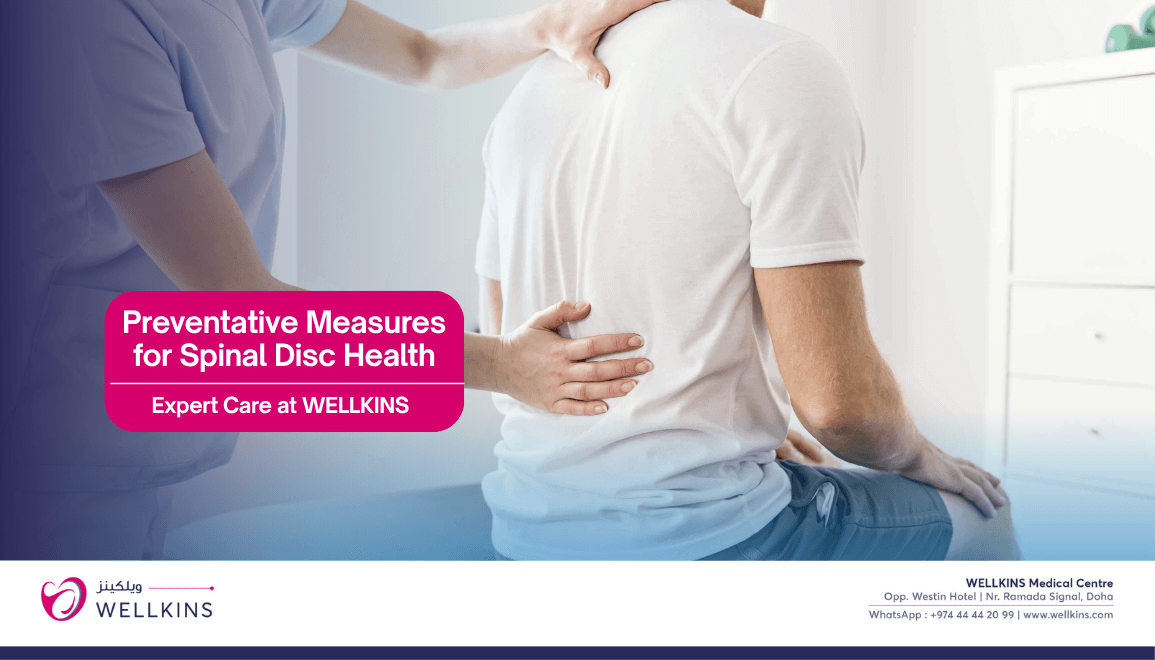
When to Seek Medical Care for Slipped Disc Symptoms
While minor back soreness often resolves on its own, it’s time to see a doctor if you experience back pain lasting more than a few days. This is particularly important if the pain is radiating down your leg (sciatica), which strongly suggests nerve irritation from a disc. You should also seek evaluation for any new or concerning sensations like numbness, tingling, or weakness in your leg or arm, as these are direct signs of nerve compression. Prompt consultation is needed if your pain worsens with movement or certain positions, indicating a mechanical issue within the spine that a healthcare provider needs to assess and diagnose.
Seek Immediate Medical Attention For:
Certain symptoms require an emergency room visit as they may indicate a severe spinal complication, such as Cauda Equina Syndrome, caused by massive disc herniation. Seek immediate medical attention for the sudden loss of bowel or bladder control, or if you notice progressive leg weakness that makes walking difficult. Other critical warning signs include numbness in the groin area (saddle anesthesia) or severe pain following an injury. These are time-sensitive neurological emergencies where quick treatment is necessary to prevent permanent nerve damage.
Prognosis and Recovery
- Early appropriate treatment
- Staying active within pain limits
- Maintaining a positive attitude
- Good overall health
Understanding your symptoms is the first step; the next is seeking expert guidance to secure a lasting solution. If you’re struggling with persistent or radiating symptoms suggestive of a herniated disc, know that effective help is available. Early and appropriate intervention is your best strategy for a complete and lasting recovery. We focus on restoring your function, managing your pain, and equipping you with the preventative knowledge to avoid future issues. Your spine health is a crucial investment in your overall quality of life and future mobility it’s time to take control and ensure it gets the expert attention it deserves
To book an appointment at Wellkins Medical Centre: https://wellkins.com/visit

